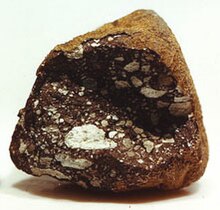Lunar meteorite
Lunar meteorites are meteorites whose origin is the moon . They were each knocked out of the moon by the impact of an asteroid or meteoroid , thrown into space and landed on Earth or another planet by chance, for example .
history
Although the first lunar meteorite (Yamato 791197) was found as early as 1979, the first evidence of the lunar origin of these meteorites was only possible on the Allan Hills 81005 specimen found in Antarctica in 1981 . This was followed by further finds from both the Antarctic and (mainly) the dry regions of North Africa. By comparing the chemical composition, mineralogy and isotope abundances between lunar meteorites and samples of lunar rocks taken from the Apollo missions , the moon is clearly established as the place of origin.
The lunar meteorites are a useful addition to the lunar samples brought back from the US and Soviet lunar missions. The moon samples from the Apollo and Luna missions were only collected from a few places in the vicinity of the respective landing sites, all of which were on the Earth-facing side of the moon. Although it is mostly not known from which place on the moon the individual previously known lunar meteorites originate, for statistical reasons it can be assumed that some also originate from the back of the moon . An exact determination of the origin was possible for the first time in Sayh al Uhaymir 169 .
In the specimen Dho 280 , abundance and two other, also previously unknown, iron-silicon mineral phases were found. Other examples of lunar meteorites are Calcalong Creek , which weighs only 19 grams, and the DAG 400, which weighs 1.4 kilograms . To date (as of May 2019) a total of 362 finds of lunar meteorites have become known. In 2017 and 2018 in particular, numerous new finds (mainly from Mauritania ) were added, with individual finds (e.g. NWA 11787) reaching masses of over 20 kg.
The discovery of the first lunar meteorite in the early 1980s led to a resurgence of speculation that there could also be meteorites from Mars. In fact, the first Martian meteorite was identified in the same year .
The existence of lunar meteorites on earth also raises the question of whether, conversely, there are also earth meteorites on the moon. The earth was subjected to heavy bombardment by asteroids between its formation 4.5 billion years ago and around 3.9 billion years ago . It is possible that stones were knocked loose from the earth and transferred to the moon. While on earth itself all rocks from this period were transformed by geological processes, they should have survived on the moon. It has therefore already been proposed to start new missions to the moon in order to specifically look for this primeval rock from the earth.
classification
Lunar meteorites are divided into five classes according to their chemical or mineralogical composition:
- Feldspar- rich ( anorthosite- rich) meteorites,
- Lunar basalt meteorites ,
- Mixtures consisting of both types of rock,
- KREEP meteorites,
- Meteorites from Olivingabbro .
Since the lunar surface is exposed to permanent meteoritic bombardment, most of the rocks close to the surface - regardless of their composition - have been brecciated by impacts , whereby three different types of structure can be distinguished:
- Monomictic fragmented rocks ( fragmented breccias ), which consist of a certain type of rock;
- Regolith breccias ( regolith breccias ), which in addition to the original rock also contain material from the surface, such as brecciated lunar rock of a different type, meteorite fragments or spherical glass particles, such as those formed when larger bodies impact;
- Breccias with impact-melt breccias , in which the matrix of the breccia consists of solidified rock melt .
Web links
- Christian Pinter: A naughty neighbor ( memento from April 19, 2005 in the Internet Archive ), Wiener Zeitung , November 14, 2003 (accessed on November 25, 2013)
- The Lunar Meteorite Compendium, NASA (English)
- Lunar Meteorite, Washington University St. Louis (English)
- List of lunar meteorites, Washington University St. Louis (English)
- The Lunar Sample Compendium, NASA (English) - no meteorites, but samples collected on the moon!
- The Curation and Analysis Planning Team for Extraterrestrial Materials
Individual evidence
- ^ Warren PH, Taylor GJ, Keil K. (1983) Regolith breccia Allan Hills A81005: Evidence of lunar origin and petrography of pristine and nonpristine clasts, Geophys. Res. Lett. 10, 779-782.
- ^ Meteoritical Bulletin Database. The Meteoritical Society, accessed May 11, 2019 .
- ↑ Monical Grady, Giovanni Pratesi, Vanni Moggi Cecchi: Atlas of Meteorites . Cambridge University Press, Cambridge 2014, ISBN 978-0-521-84035-4 , pp. 335-338 .
